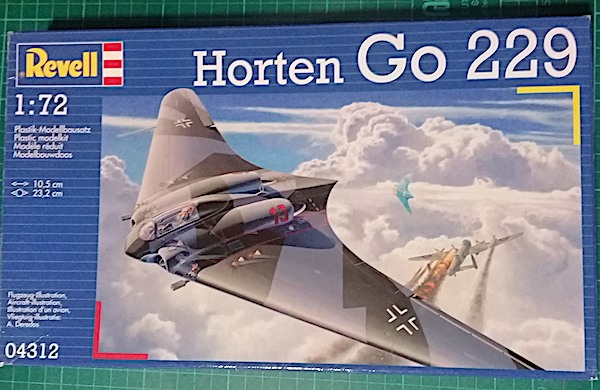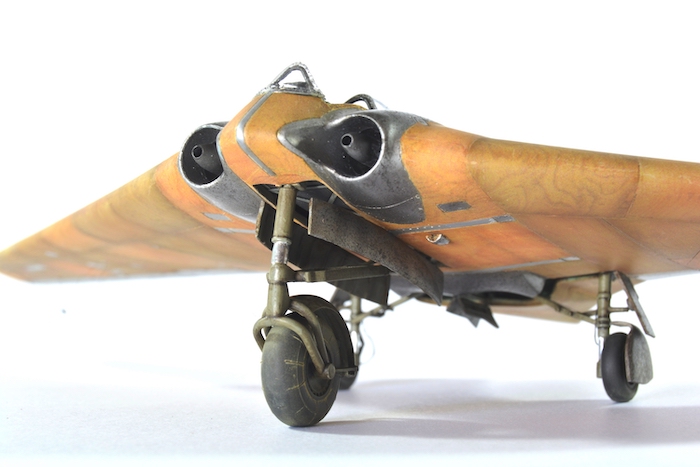
Feature Article with Ricardo Barrientos
Introduction
Hello again from Guatemala! This is the first of a series of three full in-depth articles on my latest project, three Luftwaffe jets: the Ho 229, the He 162 and the night fighter version of the Me 262. In this one, I’ll cover the build of the Horten Ho 229 V3, and since the hypothetical camouflage schemes offered in the kit didn’t convince me, I decided to build my model representing the closest appearance when General George Patton’s Third Army troops found it at Friedrichsroda, Germany, in April 1945, without paint, exposing the wood and metal of its components. After that, it received spurious camouflage and markings applied by the Americans for display purposes as a war trophy in the late 1940’s and early 1950’s. In 1952 it was transferred to the Smithsonian National Air and Space Museum (NASM), and currently is on public display in the Boeing Aviation Hangar at the Steven F. Udvar-Hazy Center in Chantilly, Virginia, United States.
Here’s a quick look at how it all turned out…

The Horten Ho 229 is quite popular among scale modellers, I suppose for various reasons, including its aesthetic and futuristic look; its unquestionable advanced design, well ahead of its time; the ongoing debate on the intention of its designers, the brothers Reimar and Walter Horten, to reduce its radar signature by its layout and materials like charcoal to absorb electrical waves, in which case, it could be the very first intended stealth aircraft, a forerunner of the Northrop B-2 stealth bomber; the interesting combination of high technology like jet engines versus cheap and non-essential materials like steel tubing and wood, among others. Whatever the reason, proof of this fascination are the impressive and delightful Zoukei-Mura kits of the Ho 229, in 1:32, 1:48, 1:72 and 1:144 scales, except the latter, showing the intricate steel tube truss.
This aircraft is highly attractive for a diversity of interests and disciplines, going from hobbies like scale modelling, to more serious scientific disciplines like history, aeronautical engineering, chemistry, physics and others. This is why during the last decades, the NASM has been receiving frequent and numerous requests to special permission to examine and study the aircraft, to restore it, or not to restore it but preserve it, etc. Also, there is plenty of references, in particular, as an historical study, I found very interesting the Shepelev, A., and Ottens, H., 2006 (re-edited in 2015) book Horten Ho 229 – Spirit of Thuringia (Crecy Publishing). And for the scale modeller, I found a delightful and impressive reference the Marek J. Murawski, Marek Ryś, 2017 book Horten Ho 229 (Kagero Monographs Special Edition in 3D), full of computer renderings, very well done, showing the aircraft components step by step.
But if you want to get really serious on Horten Ho 229 V3 references, I strongly suggest reading the wonderful research report of the NASM, available online at https://airandspace.si.edu/collections/horten-ho-229-v3/. In my opinion this technical and scientific document gives an idea of what is the current state of the art curator work in a museum preserving aircrafts. It covers the alleged stealth properties of the Ho 229, construction, materials, condition, and preservation, plus a bibliography and images. For the modeller, it gives interesting details obtained from the preservation work done so far by the NASM curators, like the unusual semi-transparent green coloured coating present selectively on both the interior and exterior of the plywood and lumber surfaces, possibly a type of PVC based fireproof product applied at the Gotha factory, another example of a feature ahead of its time. In fact, a careful examination of the NASM’s Horten pictures in which the interior is visible confirms the green colour in the interior. In any case, the meticulous modeller will convince him/herself that the inner side of the plywood panels of the Ho 229 V3 were painted with a non-RLM standard bright green.